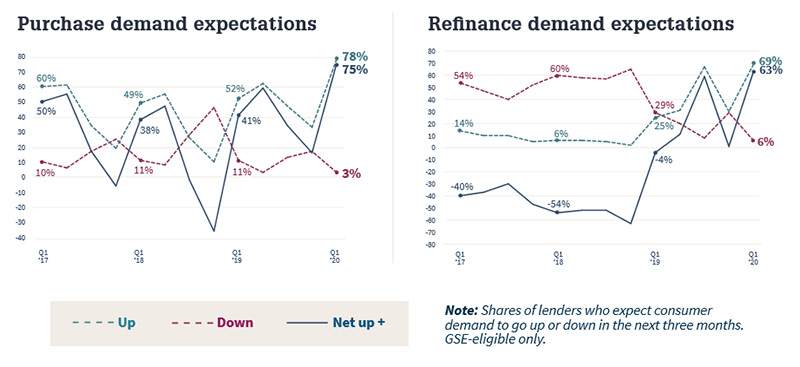Mortgage Lender Sentiment Survey - Q1 2020
Lenders' Profit Margin Outlook Also Hits High on Strong Consumer Demand
WASHINGTON, DC – Mortgage lenders’ profit margin outlook for the next three months reached a new survey high based on data collected in the first half of February, according to Fannie Mae's Q1 2020 Mortgage Lender Sentiment Survey®. This quarter, 51% of lenders believe profit margins will increase compared to the prior quarter, while 44% believe profits will remain the same and 4% believe profits will decrease. The increased optimism supplements prior quarter MLSS results revealing already-strong lender expectations of profitability. Strong consumer demand for both purchase and refinance mortgages continued to drive lenders' expectations of increased profitability, with operational efficiency cited by lenders as the second most common reason for the optimistic outlook.
"The mortgage industry has had a strong start in 2020, consistent with our forecast and the February Home Purchase Sentiment Index® released on Monday," said Fannie Mae Senior Vice President and Chief Economist Doug Duncan. "Lenders' expectations of consumer demand for purchase and refinance mortgages hit survey highs this quarter, with many lenders pointing to favorable interest rates as the engine driving the demand. The first quarter survey data, which were collected during the first two weeks of February, do not reflect the potential impact of the decline in the 10-year Treasury rate seen in recent weeks. Mortgage spreads have since widened. Given capacity constraints and continued interest rate volatility, we expect mortgage rates to continue to decline and spreads to continue to be wider throughout 2020."
"Past experience from 2012 and 2016 suggests that mortgage spreads generally take a few months to compress," continued Duncan. "We anticipate similar rate dynamics this time, depending on the path of the underlying Treasury rate. Although uncertainty around coronavirus may have a dampening effect on housing market sentiment, for now we expect the continued low interest rate environment will help bolster mortgage volume, particularly refinances, as well as lender profitability, consistent with lenders' expectations."

MORTGAGE LENDER SENTIMENT SURVEY HIGHLIGHTS:
Widened Mortgage Spreads Point to Continued Positive Profitability Outlook
Mortgage spreads have widened significantly in the first quarter, consistent with continued optimism in mortgage lenders' profitability outlook. The average primary mortgage spread (FRM 30 contract rate versus 10-year Treasury) ended February at 216 basis points, well above the long-run average of 168 basis points.
Purchase and Refinance Mortgage Demand Hits Survey Highs
For purchase mortgages, across two of the three loan types (GSE-eligible and government), the net share of lenders reporting demand growth over the prior three months reached the highest readings for any first quarter in the survey's history, as well as the highest since Q1 2015 for non-GSE-eligible loans. Meanwhile, the net share reporting growth expectations for the next three months remained positive and reached survey highs across all loan types.
For refinance mortgages, the net share of lenders reporting demand growth over the prior three months went down slightly from last quarter's survey highs but remained very strong. Demand growth expectations on net for the next three months reached new survey highs for GSE-eligible and government loans.
Credit Standards Unchanged
The pace of credit easing remained similar to last quarter. Overall, most lenders reported no major changes in their underwriting credit standards for the prior three months and expected no major changes for the next three months.
On this webpage you will find a news release with highlights from the survey results, a high-level infographic, the Q1 2020 data summary highlighting key attitudinal indicators, a detailed research report, the questionnaire used for the Q1 2020 survey, and FAQs providing additional information about the survey.
Downloads and Related Links
Q1 2020 News Release
Q1 2020 Detailed Research Report
Q1 2020 Survey Highlights (Infographic)
